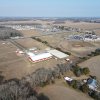Lewes’ champion hackberry; Rehoboth’s tree qualms
Delaware’s largest hackberry tree stands monumentally in St. George’s AME Church cemetery on a piece of high ground on Pilottown Road in Lewes. Many of its long, horizontal branches - each the size of a good-sized tree in its own right - spread miraculously in all directions over the cemetery. Miraculous in that the branches, cantilevering out from the tree’s prodigious trunk and weighing in excess of a ton, still manage to stay afloat in the air. Try holding your arm straight out from your body for 30 minutes and see how that feels. The champion hackberry has been holding its branches out for decades!
Delaware forestry personnel and their counterparts across the country rank their champion trees with a system that assigns points for three different measurements: height, circumference of the trunk at four and a half feet, and average crown spread. The total of the three measurements is how each tree is compared to others. It’s not necessarily the tallest trees that make for champions.
The champion hackberry in Lewes measures 46 feet tall, with a 140-inch trunk circumference and a crown spread (one point for every four feet of spread) of 72. Height number is equal to one point per foot while circumference number is one point per inch. The Lewes champion weighs in at a total of 204 points. Another companion hackberry in the cemetery is also a big one but doesn’t make the Delaware Big Tree list.
The nation’s largest hackberry, in Findlay, Ohio, dwarfs Delaware’s champion in Lewes in two out of the three measurement criteria. It is 88 feet tall and has a circumference of 268 inches. But for all that height and girth, the Ohio hackberry only has a an average crown spread number of 89. It’s the crown spread of the Lewes tree, with its massive horizontal branches shading dozens of graves, that gives it so much interest.
The cemetery that hosts the big hackberry is interesting in its own right. According to an article by Ruth Mankin in the Lewes Historical Society Journal of November 2001, followers of African Methodist Episcopal Church founder Richard Allen worshiped on a corn crib on this site in 1861. The land was donated by Peter Lewis, a free black shipbuilder who built his vessels on nearby creekside land. Lewis was one of only a very few black shipbuilders plying the trade on the East Coast of the United States.
Mankin reports that at least three black veterans of the Civil War are buried in the cemetery including a C.H. Right, Company K, 25th USCT. USCT stands for United States Colored Troops.
This conversation about trees comes at a time when Rehoboth Beach officials are expressing concern about loss of the tree canopy that gives the residential streets of the resort such a distinctively pleasing character. As property values continue to rise, demolition of many older and smaller cottages makes way for larger homes. That often means larger trees that have been growing for decades also come down to make way for the larger structures. It takes several decades for new trees to match the canopy provided by the older, larger trees even if there is room left for the more stately trees like Rehoboth’s predominant oaks to grow.
Delaware, by the way, is only one of five states in the nation that has no national champion trees. Tropical Florida, with 365 days of growing season has 111 out of 761 species of national champions.
Take a look in the photo gallery for maps of Dewey Beach, Lewes, Milton and Rehoboth Beach that show the percentage of each town’s total acreage shaded in the summer months by tree canopy.



























































